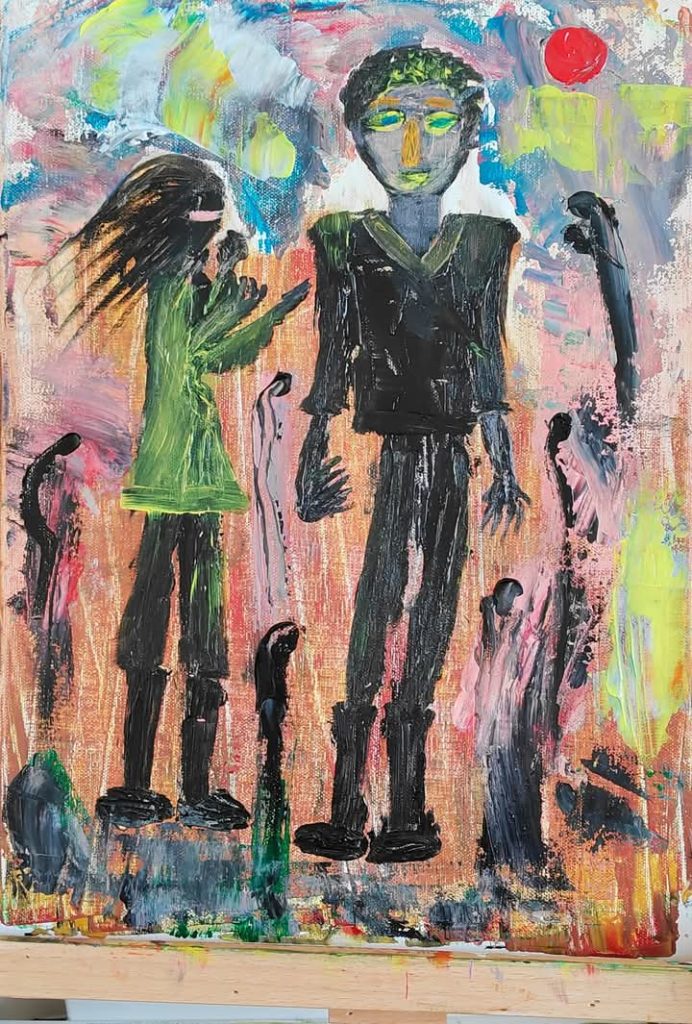Fires, L.A. Ashes is bright Malibu, Altadena’s palms, black, naked, gravel of bitter alms. Roses devour the monarch wood, blown from Santa Ana to a cold tide; rags left from brocades of towns, tapestries of cities burning down. Katy’s house, white against ash, drops tears into her outstretched hand. Great dragons of fire snake the night hills, seeking their reflections in abandoned swimming pools. _____ Christopher Bernard is a poet, novelist and essayist living in San Francisco.
Poetry from Anna Keiko

Change
Don’t walk in the corner of other people’s clothes.
Don’t do things according to other people’s faces.
It’s an asymmetrical life.
The 180-degree diagonal line can support you to stand?
Some gravitational forces are invisible.
It doesn’t come from the outside.
It’s the slant of your perception.
There are some things you can ignore
Why do things that others can do but don’t want to do?
Change is your theme.
Time is a straight line.
Is indispensable.
Written in Shanghai on January 2, 2025

Poetry from Joseph C. Ogbonna
Tese’s Historic Visit
I visited the 1917 birth
place of America’s first president
of Catholic and Irish descent.
In the historically significant
town of America’s northeast.
Once identified as the disdainful
“Beantown.”
It got me so thrilled that all I could
utter in my amazement and wildest
fascination was a jaw rending wow!!
The artefacts, the vintage furniture,
the early 20th century switch hook,
the relics of the sitting room, bedrooms,
bathrooms, restrooms and kitchen,
all aged a century plus.
The home the all time American great;
John Fitzgerald once called his childhood
home.
The childhood residence of Joe the ill-fated air man.
The childhood residence of the ambitious but tragically mowed down Bob.
The childhood residence of decades long lawmaker, Ted.
And the childhood residence of poor Kathleen, disabled Rosemary, and the athletic and philanthropic Eunice.
For me, it was nothing more than a metamorphosis of abstract history
brought to the fruition of tangible reality.
Poetry from Lazzatoy Shukurillayeva

Umring bo‘yi ishonging kelar
Buyuk bo‘lib tug‘ilganingga.
Farishtalar ishora qilar
Deya ko‘kdan sen kelganingga.
Umr o‘tdi. Chang – to‘zon aro
Bilmay bormi yo eding yo‘qdan.
Yerostiga chorlaydi sado,
Lek ishorat bo‘lmadi ko‘kdan.
● Alexander Arkadyevich Feinberg
You believe throughout your life,
That you born being great, talented
Born once in a million.
Wait for angels to prove that.
Time has gone, life ended
Without purpose and achievement
You’ve realized nothing.
Next life is waiting you, but no prove yet
● Translation by Shukurilloyeva Lazzatoy Shamshodovna
Essay from Dilshoda Izzatilloyeva

CAUSES AND TREATMENTS OF PNEUMONIA IN YOUNG CHILDREN
Abstract: This article provides information on the causes, symptoms, prevention strategies, and treatment methods of pneumonia, a disease commonly observed in children, especially during the winter season. Pneumonia is a significant respiratory infection that affects millions of children worldwide, leading to substantial illness and mortality. Understanding the various aspects of pneumonia can help take active measures to reduce its impact on children’s health.
Keywords: Pneumonia, Respiratory tract infection, TORCH infection, CBC, ESR, CRP, Treatment, Prevention.
Introduction: Every year, pneumonia is diagnosed in 17 million people worldwide. The mortality rate due to lung disease is very high, accounting for 8-9%. Pneumonia is an inflammatory process in lung tissue. In most cases, the disease is caused by infectious agents. The modes of infection transmission vary, often being spread through airborne droplets.
Main Section: Causes of Pneumonia:
Infectious (bacterial) – caused by bacteria like pneumococci, staphylococci, streptococci, etc.
Viral – caused by various viruses such as RSV and adenovirus.
Fungal – caused by molds, yeast fungi, and pneumocysts.
Mixed – in some cases, the lungs may be infected by multiple pathogens simultaneously.
Additionally, parasites can also cause pneumonia. Pneumonia tends to be more severe in children than in adults due to their underdeveloped immune system and mucociliary clearance.
Symptoms in Children:
Fever: 38-39°C or higher.
Cough: Dry or with phlegm.
Breathing difficulties: Rapid or labored breathing (fast deep breaths, shortness of breath).
Chest pain: Worsens during breathing or coughing.
Pale or bluish skin: Cyanosis due to low oxygen levels.
Loss of appetite: Refusal to eat, vomiting, or weakness.
Fatigue and weakness: Child becomes easily tired and inactive.
Abdominal pain or diarrhea.
Risk Factors During Pregnancy:
TORCH infections: Toxoplasma gondii, Rubella virus, CMV, Herpes simplex virus.
Influenza and respiratory infections.
Bacterial infections: Streptococcus group B, chlamydia, gonorrhea.
Maternal fever during pregnancy (hyperthermia).
Maternal chronic diseases: Diabetes, tuberculosis.
Passive smoking.
Vitamin and nutritional deficiencies.
Diagnostic Methods:
Complete blood count (CBC).
ESR (Erythrocyte sedimentation rate).
CRP (C-reactive protein).
Blood gas analysis.
Bacteriological analysis.
Immunological tests.
Treatment Methods: Bacterial Pneumonia:
Antibiotics such as penicillin, amoxicillin, and cephalosporins.
Viral Pneumonia:
Antiviral drugs (e.g., Oseltamivir).
Symptomatic treatment (antipyretics like paracetamol and ibuprofen).
Fungal Pneumonia:
Antifungal medications (e.g., Fluconazole).
Supportive Care:
Oxygen therapy.
Hydration and nutrition support.
Chest physiotherapy.
Prevention Measures:
Vaccination against pneumococcus and Haemophilus influenzae.
Healthy lifestyle practices.
Breastfeeding.
Maintaining hygiene and avoiding passive smoking.
Conclusion: Pneumonia is a serious health threat, especially for young children. Early diagnosis, proper treatment, and preventive strategies like vaccination and hygiene practices are crucial in reducing its impact. Strengthening healthcare services and raising awareness among parents can further aid in preventing childhood pneumonia.
References:
.Internal Diseases: Medical-Scientific Edition by Abdugaffor Gadayev. Tashkent: Muharrir Publishing, 2020.
.Hospital Pediatrics, edited by Prof. S.A. Rakhimov, Prof. A.R. Isroilov. Tashkent, 2010.
Children’s Diseases by T.A. Daminov, B.T. Kholmatova, U.R. Boboyeva. Tashkent, 2012, p.159.
United Nations Children’s Fund. 2020. Pneumonia. Available at: https:/ /data.unic ef.org / topic/childhealt h/pneumonia/
Community-acquired pneumonia in children: prevalence, diagnosis, treatment, and prevention // Scientific-practical program. Moscow: Original Maket, 2011, p.64.
Clinical Pharmacology: National Guidelines edited by Yu.B. Belousova, V.G. Kukesa, V.K. Lepakhina et al. Moscow: GEOTAR-Media, 2009, p.976.
Essay from Z.I. Mahmud (one of several)
Sylvia Plath’s Lady Lazarus and Daddy
Examine close reading of Sylvia Plath’s poems “Lady Lazarus” and “Daddy” with critical perspectives and textual references in association with the thesis statement that “Lady Lazarus” and “Daddy” both rebel coercion confinement of patriarchy and misogyny.
(Image of Sylvia Plath, young white woman with brown hair and eyes, yellow v-neck sweater, red lipstick and a headband)
Examine close reading of Sylvia Plath’s poems “Lady Lazarus” and “Daddy” with critical perspectives and textual references in association with the thesis statement that “Lady Lazarus” and “Daddy” both rebel coercion and confinement of patriarchy and misogyny.
Sylvia Plath’s “Lady Lazarus” and “Daddy” are conical works of transcendentalist American feminism posthumously anthologized in the poetry collection Ariel in 1965. American poetesses’ egotistical individuality and romanticist fantasy of selfhood quest crusading the forces of sublimity is universally foreshadowed by the phenomenal poems. Gloom and doom, dark humour and black humour engender the motifs of revenge and memory through mythologization, poeticization, psychologization, romanticization and/or fantasization in these quasi-confessional and quasi autobiographical elegies.
“Lady Lazarus” is a vindication of the temptation of fate as implied in the poetical rhetorics: “Herr God, Herr Lucifer”/ “Beware/ Beware”. Epiphanic voice of the romanticist egomaniacal heroine of femininity is reflected in the biblical figuration of the transformative poetess. The resurrectionist figuration is an avenging phoenix that transcends the contemporary recalcitrant barriers of race, class, ethnicity, gender, nationality and culture[al] stereotyp[ical]es expectations of the hackneyed microcosm. This overarching feminist emancipation salvages herself by historicizing in the hyperbolic figurative tropes foreshadowing: “Out of the ash/ I rise with my red hair/ And I eat men like air.” Etherealism and surrealism surmounts in the reincarnation and resurrection impresarios of “Lady Lazarus”.
On the contrary, “Daddy” was merely the first jet of flames from a literary dragon, who in the last years of her life breathed a burning river of bale across the literary landscape. “Daddy” is a subversive indictment of overarching feminism harbouring cantankerousness and obstreperousness against patriarchal dominance. “Daddy, daddy, you bastard. I’m through…” is the culmination of a matriarchal feminist stance of the woman poet in accord with the second and third wave of feminism epochs. American poetess Sylvia Plath’s invocation of fascism and nazism is entwined in the impresario that she envisions witnessing renderings of holocaust Nazi cremation of the extermination in concentration camps and the associated violence and trauma of survivialhood. This documentary testament bears antisemitism as projected by the figurative tropes: “my skin/bright as a Nazi lampshade” and “my face…/… Jewish linen”.
Quintessential poetry of the grotesquery of suffering and vulnerability are starkly evident in both the poems. In comparison, both of these poems are embodiments of empowered femininity through canonical works of women writing. “Lady Lazarus” fictional character and poetic personae reawakens and resurrects the graveyard tombed femininity in avenging the suicidal despair—-”It’s a theatrical comeback in broadway” echoes and resonates the revenge fantasy of impulsive and ironwilled “Lady Lazarus’s” femininity—a noteworthy exploration of second and third wave feminism. In contrast, “Daddy” disempowers patriarchal subjectivity of the object of male gaze, which views womanhood and femininity as commodities of objectification and fetishization.
“And a head in the freakish Atlantic/ Where it pours bean-green over blue/ In the waters of the beautiful Nauset”. Elegiac diatribe imperils the fatherly figure’s imperious and domineering spirits: closure of relationship; association to racism of antisemitism: furtherance to the testament of burgeoning and full fledged feminist movements. In a nutshell, “Daddy” is a melodramatic treasure hunt of communion of torture, trauma, massacre, sacrifical martyrdom and survivalist victimhood. Cultural appropriation of the imaginary Plathian canonical homeland casts a role as the subversive counter cultural feminine speaking back to the dominant masculinist authoritarianism and hegemony. Moreover, obituary and elegy of the electra complex critiquing the fascist vampiric perpetrator’s predatoriness as morbidly entrenched within the masculinist domain. Perceptive subjectivity of being deported to the Holocaust concentration camp is envisioned and foretold by the metaphors of apocalyptic gloom and doom as embodied by the wretchedness and viciousness of fathers and husbands in general. Despite the heritage of the dictatorial regime and patriarchal misogyny, “Every woman adores a fascist” … “And get back, back, back to you.”
“Lady Lazarus” and “Daddy” voices puritanical spirits of protest against rigidified and terroristic visions of male power and masculinist authority. These poems canonize themselves as transgressive dialects transforming invisibility to visibility and private as public.
Further Reading, References, Endnotes and Podcasts
Stripped Cover Lit Lady Lazarus by Sylvia Plath Poetry Discussion: Summary, Analysis, Interpretation, Review
A Lecture on Sylvia Plath’s “Lady Lazarus” and “Daddy” John Pistelli
2.72K subscribers
Daddy by Sylvia Plath Summary, Analysis, Themes, Review Stripped Cover Lit 14K subscribers
American Literature | Sylvia Plath: analysis of “Daddy” | Poem analysis Ad Maiora
83.7K subscribers
Lady Lazarus by Sylvia Plath in 8 minutes Simon Andrew
1.23K subscribers
Daddy by Silvia Plath Simon Andrew 1.23K subscribers
Review – Lady Lazarus (Sylvia Plath) – Patron Poem
Stripped Cover Lit
14K subscribers
Sylvia Plath, Cliffs Notes on American Poets of the 20th Century Mary Ellen Snodgrass, M.A. University of North Carolina, Greensboro, Lincoln, Nebraska, pp. 211-217, 2000.
“Daddy” Jacqueline Rose, Bloom’s Modern Critical Views: Sylvia Plath (2007), Bloom’s Literary Criticism, pp. 38-51
Chapter Title: Plath’s Bodily Ego Restaging the Sublime, Book Title: Women Poets and the American Sublime, Joanne Feit Diehl, Indiana University Press (1990) pp. 1-32
Wikipedia Readings
Poetry from J.J. Campbell

—————————————————————————-
the breakfast of a champion
leftovers and
christmas cookies
the breakfast
of a champion
how much liquor
in the coffee this
morning
whatever it takes
to avoid the inevitable
chasing death like
a whore in church
that dark haired vixen
of the teenage years
imagine if she would
have said yes and all
this bullshit would
have never happened
imagine if you were
actually someone
worth saying yes
to
————————————————————————
a visit to the doctor before a snowstorm
blood pressure of
someone in perfect
health
blood sugar of
someone that will
be dead in a few
months
more scratches of
the head than i have
seen in years
but as always
what designer drug
will the insurance
pay for
i guess the pain
can wait
i suppose all this
booze is here for
a reason
———————————————————————–
flirting with disaster
one of these nights
one of these drinks
will probably kill
me
i feel like i am an
expert at flirting
with disaster
a quick tongue
will get you
places in these
sordid circles
she does believe
we are going to
spend forever
in harmony
i hate to break
it to her
but the chances
of that happening
are even worse
than my impending
doom
—————————————————————————
just a few inches
snow on the way
now the panic
will set in
long lines for
gas and groceries
jesus christ
just a few inches
some stupid fuck
will ask where
the hell is global
warming now
this is when i
would love to
grab him and
tell him about
the good ole’
days of four
fucking seasons
instead of just
hot and cold
———————————————————————-
into something beautiful
and here comes
this angel willing
to grab me by the
throat and drag me
into this century
of course, as much
as i want to believe
she has my best
interests in mind
this fucking wall
i have been building
won’t allow my
complete belief to
grow into something
beautiful
this is where the
distance apart
is my friend
allows me many
miles to get my
split brain back
into one
i hope those stunning
eyes meet me on some
edge of the world
and we both decide
to fucking jump
J.J. Campbell (1976 – ?) is a 3 time Best of the Net nominee and a recent Pushcart Prize nominee. He’s been recently published at The Beatnik Cowboy, The Dope Fiend Daily, Disturb the Universe Magazine, Horror Sleaze Trash and Yellow Mama. He is currently working on a yet to be titled book of new poems. You can find him most of the time on his mildly entertaining blog, evil delights. (https://evildelights.blogspot.com)
